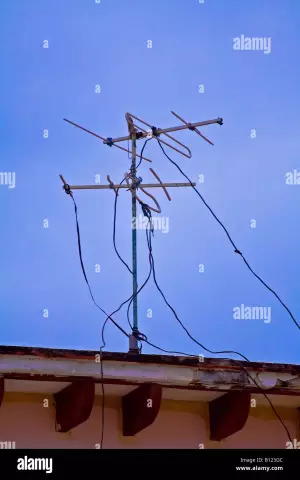Many devices equipped with radios and transmitters have external antenna inputs. The use of an external antenna instead of an internal one can significantly improve the communication quality.
Instructions
Step 1
Radios are often equipped with slots marked with the letter A or a sign similar to the letter Y, but with an additional third vertical line in the middle. It is in this socket and connect the antenna. If it is outdoor, it must be equipped with a lightning switch and grounded before a lightning storm.
Step 2
Some receivers also have grounding sockets. Such devices must not be connected to receivers powered from mains without a transformer. On their back walls there is an inscription “Do not include the earth”. If the receiver does not have an antenna socket, but has a telescopic antenna, you can connect an indoor antenna with a crocodile clip to it - an insulated wire several meters long. Reception will get better.
Step 3
To improve reception at low frequency bands, you can wind several turns of wire directly onto the body of a small-sized receiver so that the axis of the resulting coil is parallel to the axis of the magnetic antenna. Connect one of the leads of the coil to a similar indoor antenna.
Step 4
TVs used to have clamps for a flat 300 ohm antenna cable. Now all TVs are equipped with coaxial jacks for connecting a 75-ohm cable. Use a standard antenna plug to connect such a cable to the unit. Indoor antennas with 300 ohm flat cables are still available today. They include an adapter with a matching transformer. The plug built into the adapter can be plugged into a coaxial jack.
Step 5
A modern TV has one socket for a broadband antenna that works in all bands. An old TV may have separate sockets for VHF and UHF antennas, as well as an additional socket with a voltage divider by 10, which is advisable to use with a strong signal. Antenna socket can be labeled Antenna In, Aerial or similar, or a stylized letter T, as if consisting of two letters G - mirrored and regular.
Step 6
The music centers are equipped with sockets for a loop antenna for low-frequency ranges and an antenna-dipole for high-frequency ranges. If the first antenna is lost, wind ten turns of insulated wire on a ten centimeters diameter frame and connect to the appropriate sockets. If there is no second antenna, take a TV indoor antenna with a 300-ohm flat cable, remove the transformer adapter from it and connect it to the jacks of the music center designed for the dipole. Clips for antennas are designated by the inscriptions Antenna, Aerial, AM loop (for a loop antenna), FM dipole (for a dipole), etc.
Step 7
Many cell phones have small coaxial jacks for an external antenna. If there is no such slot directly on the back wall, it may be under the battery cover, but there may not be a hole in the cover. But then you can use the external antenna only with the cover removed, which is inconvenient - the battery may fall out.
Step 8
It is necessary to connect and disconnect the antenna very carefully so as not to spoil the miniature jack. The plug must be factory-made for use with cell phones. There are usually no inscriptions next to the antenna socket. It is cylindrical, has a diameter of several millimeters and is gilded. Sometimes it is not there at all, even under the lid.
Step 9
External antennas are not connected to 75-ohm, but 50-ohm coaxial cable to radio stations of the C-Bi range (27 MHz). Antenna socket and BNC plug have a snap-in design to prevent falling out. It is impossible to turn on the radio station for transmission without an antenna - the transmitter amplifier may deteriorate. The same can happen from using the wrong antenna, 75-ohm cable instead of 50-ohm, and even just if the cable is broken. For a portable radio, the antenna jack is located on top, for a stationary or car radio - on the back wall.
Step 10
Satellite antennas are not connected directly to the receivers, but through converters, mounted directly on the "Plates". For this, special sockets, plugs and cables with low attenuation at significant frequencies are used. The same cable supplies the supply and control voltages to the converter. The converter socket is located on the back of the receiver.






